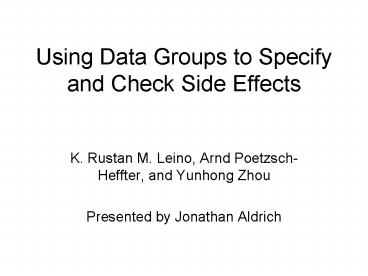Using Data Groups to Specify and Check Side Effects - PowerPoint PPT Presentation
Title:
Using Data Groups to Specify and Check Side Effects
Description:
{ var n := v.cnt; push(st, 3); assert (n=v.cnt); w(st, st.vec) Problem: st.vec ... then s != t.f. In particular, since w(st, v) can modify st.contents, then v ! ... – PowerPoint PPT presentation
Number of Views:35
Avg rating:3.0/5.0
Title: Using Data Groups to Specify and Check Side Effects
1
Using Data Groups to Specify and Check Side
Effects
- K. Rustan M. Leino, Arnd Poetzsch-Heffter, and
Yunhong Zhou - Presented by Jonathan Aldrich
2
Outline
- The Problem
- Checking effects in a modular and extensible way
- Data Groups
- Aliasing Restrictions
- Discussion
3
Effect Specifications
- proc p(x,y) modifies x.f,y.g ...
- Describes the variables p might modify
- Uses
- Optimizations
- Bug finding
- Semantics
4
Specification Challenges
- proc p(x,y) modifies x.f,y.g ...
- Information hiding
- Dont want to reveal fields f and g
- Extensibility
- proc subcls.p(x,y) modifies x.f,y.g,x.h
- Soundness
- Does p(x,y) modify y.f?
5
Outline
- The Problem
- Data Groups
- Aliasing Restrictions
- Discussion
6
Data Group
- A set of variables and nested data groups
- Membership defined incrementally
- A field/group can be part of multiple groups
- // class Collection
- group state
- group elems in state
- field array in elems
- // class Vector extends Collection
- field cnt in elems
group state
group elems
field array
field cnt
7
Effect Specifications
- proc add(coll,o) modifies coll.elems
- Information hiding
- List data groups rather than fields
- Can hide fields behind module interface
- Extensibility
- Subclasses add new fields to existing groups
- So, Vector.add can modify size
- What about soundness, expressiveness?
8
Pivot Fields
- // class Stack
- group contents
- field vec maps elems into contents
- proc push(stk,o) modifies stk.contents
- Provides hierarchy
- Effect on vec specified through stks group
9
Outline
- The Problem
- Data Groups
- Aliasing Restrictions
- Discussion
10
Aliasing Problem 1
- proc m(st, r) modifies r.obj
- impl q()
- var st new()
- var result new()
- m(st,result)
- var v result.obj
- var n v.cnt
- push(st, 3)
- assert (nv.cnt)
- impl m(st, r) r.obj st.vec
Modifies v.contents (including v.cnt) if v st
11
Pivot Uniqueness
- Three restrictions
- Pivot fields can only be assigned new or null
- Cant assign a pivot field to anything
- This avoid the previous problem
- Can pass as parameter
- But cant assign to/from formal parameters
- Aliasing Invariant
- Pivot fields are unique
- Except for formal parameter aliases
12
Aliasing Problem 2
- proc w(st, v) modifies st.contents
- impl w(st,v)
- var n v.cnt
- push(st, 3)
- assert (nv.cnt)
- w(st, st.vec)
Problem st.vec is available through both st and
v in w, but this alias is not obvious in w
13
Owner Exclusion
- Suppose f maps x into g
- If p(s) can modify t.g, then s ! t.f
- In particular, since w(st, v) can modify
st.contents, then v ! st.vec - Question how do they verify owner exclusion?
- What about w(st1, st2.vec)
- where st1 st2?
- I think they would conservatively reject this,
even in cases where st1 ! st2 - To do better youd have to track more
(non-)aliasing
14
Outline
- The Problem
- Data Groups
- Aliasing Restrictions
- Discussion
15
Extensible Specifications
- Data groups
- subclasses add new groups, new fields to existing
groups - Ownership
- subclasses add new domains, new objects to
existing domains - Typestate
- subclasses add new typestates, new predicates
over added fields
16
Ownership vs. Data Groups
- Data groups can overlap
- Allows a field to hold state that is conceptually
part of two groups - Ownership is more flexible
- Can express iterator, observer idioms
- How to specify effects for these idioms?
17
Ownership for Effect Specs
- Some work in this area already
- Clarke Drossopolou
- Ownership could support iterator effects
- Call add on an Iterator in the c.iters domain
- Effect is c.elems
18
S/W Arch. and Effect Specs
- Global Effect Problem
- Notify callbacks can have large, arbitrary
effects - The Achilles' heel of existing effect systems
- Specifying all effects does not scale
- Specifying global effects causes coupling
- Solution Local Effect Specs?
- Specify only the locally visible effect within
a component - All effects on local and shared data
- All calls to external functions
- Document assumptions about locally-visible
effects of external functions - Component composition must respect assumptions
- Global effects computed from local specs
architecture

